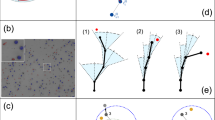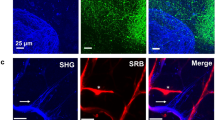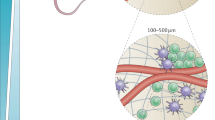Abstract
Chemokines have a central role in regulating processes essential to the immune function of T cells1,2,3, such as their migration within lymphoid tissues and targeting of pathogens in sites of inflammation. Here we track T cells using multi-photon microscopy to demonstrate that the chemokine CXCL10 enhances the ability of CD8+ T cells to control the pathogen Toxoplasma gondii in the brains of chronically infected mice. This chemokine boosts T-cell function in two different ways: it maintains the effector T-cell population in the brain and speeds up the average migration speed without changing the nature of the walk statistics. Notably, these statistics are not Brownian; rather, CD8+ T-cell motility in the brain is well described by a generalized Lévy walk. According to our model, this unexpected feature enables T cells to find rare targets with more than an order of magnitude more efficiency than Brownian random walkers. Thus, CD8+ T-cell behaviour is similar to Lévy strategies reported in organisms ranging from mussels to marine predators and monkeys4,5,6,7,8,9,10, and CXCL10 aids T cells in shortening the average time taken to find rare targets.
This is a preview of subscription content, access via your institution
Access options
Subscribe to this journal
Receive 51 print issues and online access
$199.00 per year
only $3.90 per issue
Buy this article
- Purchase on SpringerLink
- Instant access to full article PDF
Prices may be subject to local taxes which are calculated during checkout




Similar content being viewed by others
References
Bromley, S. K., Mempel, T. R. & Luster, A. D. Orchestrating the orchestrators: chemokines in control of T cell traffic. Nature Immunol. 9, 970–980 (2008)
Cyster, J. G. Chemokines, sphingosine-1-phosphate, and cell migration in secondary lymphoid organs. Annu. Rev. Immunol. 23, 127–159 (2005)
Ebert, L. M., Schaerli, P. & Moser, B. Chemokine-mediated control of T cell traffic in lymphoid and peripheral tissues. Mol. Immunol. 42, 799–809 (2005)
Bartumeus, F., Peters, F., Pueyo, S., Marrase, C. & Catalan, J. Helical Lévy walks: adjusting searching statistics to resource availability in microzooplankton. Proc. Natl Acad. Sci. USA 100, 12771–12775 (2003)
Reynolds, A. M. & Frye, M. A. Free-flight odor tracking in Drosophila is consistent with an optimal intermittent scale-free search. PLoS ONE 2, e354 (2007)
Humphries, N. E. et al. Environmental context explains Lévy and Brownian movement patterns of marine predators. Nature 465, 1066–1069 (2010)
de Jager, M., Weissing, F. J., Herman, P. M. J., Nolet, B. A. & van de Koppel, J. Lévy walks evolve through interaction between movement and environmental complexity. Science 332, 1551–1553 (2011)
Boyer, D. et al. Scale-free foraging by primates emerges from their interaction with a complex environment. Proc. R. Soc. Lond. B 273, 1743–1750 (2006)
Reynolds, A. M. et al. Displaced honey bees perform optimal scale-free search flights. Ecology 88, 1955–1961 (2007)
Sims, D. W. et al. Scaling laws of marine predator search behaviour. Nature 451, 1098–1102 (2008)
Montoya, J. G. & Liesenfeld, O. Toxoplasmosis. Lancet 363, 1965–1976 (2004)
Denkers, E. Y. et al. Perforin-mediated cytolysis plays a limited role in host resistance to Toxoplasma gondii . J. Immunol. 159, 1903–1908 (1997)
Gazzinelli, R., Xu, Y., Hieny, S., Cheever, A. & Sher, A. Simultaneous depletion of CD4+ and CD8+ T lymphocytes is required to reactivate chronic infection with Toxoplasma gondii . J. Immunol. 149, 175–180 (1992)
Suzuki, Y., Orellana, M. A., Schreiber, R. D. & Remington, J. S. Interferon-γ: the major mediator of resistance against Toxoplasma gondii . Science 240, 516–518 (1988)
Sallusto, F., Geginat, J. & Lanzavecchia, A. Central memory and effector memory T cell subsets: function, generation, and maintenance. Annu. Rev. Immunol. 22, 745–763 (2004)
Sallusto, F., Lanzavecchia, A. & Mackay, C. R. Chemokines and chemokine receptors in T-cell priming and Th1/Th2-mediated responses. Immunol. Today 19, 568–574 (1998)
Strack, A., Schluter, D., Asensio, V. C., Campbell, I. L. & Deckert, M. Regulation of the kinetics of intracerebral chemokine gene expression in murine Toxoplasma encephalitis: impact of host genetic factors. Glia 40, 372–377 (2002)
Khan, I. A. et al. IP-10 is critical for effector T cell trafficking and host survival in Toxoplasma gondii infection. Immunity 12, 483–494 (2000)
Wilson, E. H. et al. Behavior of parasite-specific effector CD8+ T cells in the brain and visualization of a kinesis-associated system of reticular fibers. Immunity 30, 300–311 (2009)
Cahalan, M. D. & Parker, I. Choreography of cell motility and interaction dynamics imaged by two-photon microscopy in lymphoid organs. Annu. Rev. Immunol. 26, 585–626 (2008)
Miller, M. J., Wei, S. H., Parker, I. & Cahalan, M. D. Two-photon imaging of lymphocyte motility and antigen response in intact lymph node. Science 296, 1869–1873 (2002)
Zumofen, G. & Klafter, J. Laminar–localized-phase coexistence in dynamical systems. Phys. Rev. E 51, 1818–1821 (1995)
Newman, M. E. J. Power laws, Pareto distributions and Zipf’s law. Contemp. Phys. 46, 323–351 (2005)
Johnson, J. B. & Omland, K. S. Model selection in ecology and evolution. Trends Ecol. Evol. 19, 101–108 (2004)
Potdar, A. A., Lu, J., Jeon, J., Weaver, A. M. & Cummings, P. T. Bimodal analysis of mammary epithelial cell migration in two dimensions. Ann. Biomed. Eng. 37, 230–245 (2009)
Budhu, S. et al. CD8+ T cell concentration determines their efficiency in killing cognate antigen-expressing syngeneic mammalian cells in vitro and in mouse tissues. J. Exp. Med. 207, 223–235 (2010)
Li, Y., Karlin, A., Loike, J. D. & Silverstein, S. C. Determination of the critical concentration of neutrophils required to block bacterial growth in tissues. J. Exp. Med. 200, 613–622 (2004)
Viswanathan, G. M. et al. Optimizing the success of random searches. Nature 401, 911–914 (1999)
Reynolds, A. M. & Bartumeus, F. Optimising the success of random destructive searches: Lévy walks can outperform ballistic motions. J. Theor. Biol. 260, 98–103 (2009)
Sims, D. W., Righton, D. & Pitchford, J. W. Minimizing errors in identifying Lévy flight behaviour of organisms. J. Anim. Ecol. 76, 222–229 (2007)
Pepper, M., Dzierszinski, F., Crawford, A., Hunter, C. A. & Roos, D. Development of a system to study CD4+-T-cell responses to transgenic ovalbumin-expressing Toxoplasma gondii during toxoplasmosis. Infect. Immun. 72, 7240–7246 (2004)
Dzierszinski, F. et al. Presentation of Toxoplasma gondii antigens via the endogenous major histocompatibility complex class I pathway in nonprofessional and professional antigen-presenting cells. Infect. Immun. 75, 5200–5209 (2007)
Wilson, E. H., Wille-Reece, U., Dzierszinski, F. & Hunter, C. A. A critical role for IL-10 in limiting inflammation during toxoplasmic encephalitis. J. Neuroimmunol. 165, 63–74 (2005)
Acknowledgements
This work was supported by grants from the National Institutes of Health AI-41158 (C.A.H.), AI-42334 (C.A.H.), EY-021314 (C.A.H.), T32-AI-055400 (T.H.H.), AI-081478 (T.H.H.), CA-069212 (A.D.L.), RNS-072298 (E.H.W.) and AI-090234 (B.J.); the National Science Foundation DMR-0520020 (E.J.B.) and DMR-1104637 (E.J.B. and A.J.L.); the state of Pennsylvania; Japan Society for the Promotion of Science Grant-in-Aid for Scientific Research Grant 20592071 (K.N.); and the Ministry of Education, Culture, Sports, Science and Technology of Japan (K.N.). We acknowledge L. Zhang and the Penn Vet Imaging Facility for technical assistance.
Author information
Authors and Affiliations
Contributions
T.H.H. and E.J.B. contributed equally to this work. T.H.H. performed the immunological in vivo and imaging studies and wrote the paper. E.J.B. performed analysis of T-cell migration and designed the mathematical model. K.N. and E.D.T.W. collected data. A.J.L. and C.A.H. were involved in study design and contributed equally. All authors discussed the results and commented on the manuscript.
Corresponding authors
Ethics declarations
Competing interests
The authors declare no competing financial interests.
Supplementary information
Supplementary Information
This file contains Supplementary Figures 1-10, Supplementary Tables 1-3, a Supplementary Discussion, Supplementary Text and Data, additional references and legends for Supplementary Movies 1-3. (PDF 806 kb)
Supplementary Movie 1
This movie shows OT-IGFP migration in the brains of control mice - see the Supplementary Information file for full legend. (MOV 4645 kb)
Supplementary Movie 2
This movie shows OT-IGFP migration in the brains of anti-CXCL10-treated mice – see the Supplementary Information file for full legend. (MOV 3610 kb)
Supplementary Movie 3
This movie shows OT-IGFP migration in the brains of pertussis-toxin-treated mice – see the Supplementary Information file for full legend. (MOV 2458 kb)
Rights and permissions
About this article
Cite this article
Harris, T., Banigan, E., Christian, D. et al. Generalized Lévy walks and the role of chemokines in migration of effector CD8+ T cells. Nature 486, 545–548 (2012). https://doi.org/10.1038/nature11098
Received:
Accepted:
Published:
Issue Date:
DOI: https://doi.org/10.1038/nature11098
This article is cited by
-
Hemocytes in Drosophila melanogaster embryos move via heterogeneous anomalous diffusion
Communications Physics (2022)
-
Fractional neural sampling as a theory of spatiotemporal probabilistic computations in neural circuits
Nature Communications (2022)
-
Motility Switching and Front–Back Synchronisation in Polarised Cells
Journal of Nonlinear Science (2022)
-
Doppler imaging detects bacterial infection of living tissue
Communications Biology (2021)
-
Lévy walk dynamics explain gamma burst patterns in primate cerebral cortex
Communications Biology (2021)



